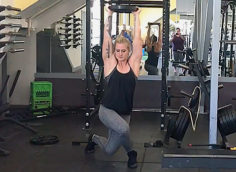Back in the mid '90s, I was an avid Muscle Media 2000 reader. As a young punk in his teens, I had a lot to learn about training and MM2K was just the ticket. Not only was it the initial exposure to my current mentor of penmanship, TC, but it also served as an influential introduction to a handful of outstanding strength coaches. In fact, MM2K was where I first learned about Charles Poliquin.
At that point in my life, I weighed in at an astonishingly pathetic 181 lbs (keep in mind, I'm 6'3"). One of my numerous shortcomings–in terms of hypertrophy–was my thigh musculature. At the age of 18, I'd spent the previous ten years with basketball as my primary passion. Since we all know how aerobically-demanding basketball is, it was no surprise that I couldn't add lower-body mass. But my off-season mass-building shortcomings remained elusive.
I was intrigued by the idea of becoming a strength coach and writer. In addition, I had scads of queries that needed professional attention. Therefore, I purchased a phone consultation with Poliquin. It wasn't cheap–by any stretch of the imagination–but I felt it was worth it.
So, I explained the situation to Charles. He informed me that the years I'd spent playing basketball weren't allowing me to build appreciable levels of thigh mass in the off-season. During the phone consultation, he didn't give a scientific explanation for his reasoning.
Looking back, I think it had to do with one or two of the following issues:
- He felt I probably wouldn't understand the science since I was only 18. (Well, I can't really blame him since I would've done the same if I was in his shoes).
- While unlikely, it's possible he didn't know the specific reason. Oftentimes, we as strength coaches don't know why a phenomenon occurs, we just know it does.
These days, I'm the one giving phone consultations. I must say, life is much more grandiose on this end of the line. Even though I'm becoming well-known in this field–and even though I attend conferences and give seminars–I've never met Poliquin in person. But, I can honestly say that my phone consult with him fueled my desire to become a strength coach. Later, I started following Louie Simmons' writings, and I was sold.
These days, I've found my own voice, but Charles and Louie definitely helped shape my tone.
But, something else has changed. I now know the answer to my teenage, no-muscle-sportin', scrawny chicken leg and ass dilemma. What's the answer? Well, you've gotta read on for this Dubya's version of The Rest of the Story.
Unless you're a bench-warmer, basketball is primarily an aerobic sport. Yes, anaerobic systems come into play, but the aerobic system dominates. This was especially true in my case because of the insufficient number of players on my team. You see, my school was so damn small that we didn't have enough players to fill the Jr. Varsity and Varsity squad. Guess what that meant? I had to play a starting role on both teams! Yep, I was scrawny, but I sure had a high VO2 max. Now, that'll impress the chicks, right?
These days, I'm no longer running up and down the hardwood floors. Instead, my ass is plopped down at my desk in front of a pile of studies that resembles the Leaning Tower of Pisa. Recently, I've been enmeshed in numerous studies that relate to muscle fiber transition.
Human skeletal muscle fibers are extremely malleable. Basically speaking, they are highly adaptive to the demands placed upon them. The most credible, recent evidence shows that seven muscle fiber types exist (depending on how nit-picky you want to get).[1] They form a continuum of fiber types from slowest to fastest, based on myosin ATPase activity under acidic and alkaline conditions. The fiber type continuum, from slowest to fastest, looks like this:
I → IC → IIC → IIAC → IIA → IIAB → IIB
The left (slowest) end of the continuum depicts fiber types with the greatest endurance potential, and lowest growth potential. The middle to right end of the spectrum depicts the fibers with lesser endurance capabilities, but highest growth potential. The majority of human skeletal muscle possesses the three primary fiber types. Although, based on the muscle group in question, other hybrid fibers can exist.
Long-duration endurance training protocols, performed for as little as 8 weeks, will cause a significant transition of muscle fiber characteristics towards more endurance qualities. When you perform long-duration endurance exercise for a period of weeks or months, a significant upregulation of type IIC fibers have been shown, while type IIB fibers subsequently plummet.[2] More recent investigation, based upon myosin heavy chain (MHC) isoform analysis, has shown a similar response with increased endurance fiber transitions.[3]
If any of you still question the muscle-wasting role that long-duration running (e.g. a 40 minute run) can have on lower-body mass, it's time to get out of the dark. The loss of muscle that occurs from the oxidative stress of long-duration endurance training has been shown. [4,5] In other words, not only will endurance training (e.g. basketball) upregulate endurance fibers, it'll also degrade the fast, type II fibers. Much of this loss of muscle is due to the catabolic hormones that endurance running induces.[6] No wonder I couldn't add any thigh mass during my basketball days!
Now, the question arises, "CW, what should I do if I've been aimlessly running for hours and I want to add mass?" Well, stop running for long periods of time! Okay, I'll be more specific. Here's what you should do to offset the damage that long-duration endurance training has already induced:
1 Train Heavy
Numerous studies have elucidated the fact that heavy-load training can cause a fiber shift towards the right end of the above spectrum.[2,7] How heavy? The heavier, the better. Be sure to shoot for a set/rep volume of 24-50 with a load >80% of 1RM. Even though I'm a fan of alternating between low and high-rep training sessions throughout the week, this is not what I recommend for former endurance athletes who want to add mass. Yes, you must still constantly rotate your parameters, but keep the load at least 80% of your 1RM. A good example would be:
- Monday
- Exercise: Squats
- Sets: 10
- Reps: 3
- Load: 80% of 1RM
- Rest: 90s between sets
- Thursday
- Exercise: Deadlifts
- Sets: 5
- Reps: 5
- Load: 85% of 1RM
- Rest: 120s between sets
2 Perform Short-Duration High-Intensity Sprint Sessions
Short sprint-training for distances such as 40 and 100M are outstanding for thigh development since it primarily taxes the type IIA and type IIB (hopefully) muscle fibers. Perform two sessions each week with each session consisting of 6-10 sprints. Utilize a work/rest ratio of 1:20 as a good starting point. (In other words, if it takes you 10 seconds to run your sprint, rest for 10x20 seconds, or 200 seconds between sprints.
3 Perform Short-Duration Steep Incline Walking Sessions
This is one of my favorite choices since it'll really improve calf development. Get on a treadmill with the incline set to 10-12%, and walk for 10-12 minutes. Not only will you improve your calf girth, it'll also serve as an active recovery session without causing excessive slow muscle fiber transitions. Perform this method 2-3x/week on your non-training days.
Many of you – and I'm in the same boat–possess naturally skinny legs when untrained. I'd like to be able to tell you that it's possible to convert your puny type I fibers into massive type II fibers, but I'm not so quick to draw my Glock.
You see, such a phenomenon has been shown [8], but the results could not be replicated in a subsequent study.[9] As a scientist in training, I know how important it is to be able to reproduce results. Therefore, the jury's still out on the type I → type II conversion capabilities of human skeletal muscle, but I've got my fingers crossed!
Now, you have a scientific explanation why you shouldn't spend countless hours on the treadmill trip to nowhere!
- Staron RS. Human skeletal muscle fiber types: delineation, development, and distribution. Can J Appl Physiol. 1997 Aug;22(4):307-27. PubMed.
- Kraemer WJ et al. Compatibility of high-intensity strength and endurance training on hormonal and skeletal muscle adaptations. J Appl Physiol (1985). 1995 Mar;78(3):976-89. PubMed.
- Liu Y et al. Effects of high-intensity and low-intensity endurance training on myosin heavy chain isoform expression in highly trained rowers. Int J Sports Med. 2003 May;24(4):264-70. PubMed.
- Terados N et al. Decrease in skeletal muscle myoglobin with intensive training in man. Acta Physiol Scand. 1986 Dec;128(4):651-2. PubMed.
- Klausen K et al. Adpative changes in work capacity, skeletal muscle capillarization and enzyme levels during training and detraining. Acta Physiol Scand. 1981 Sep;113(1):9-16. PubMed.
- Galbo H. Hormonal and metabolic adaptation to exercise. New York: Thieme-Stratton. 1983:46-51.
- Adams GR et al. Skeletal muscle myosin heavy chain composition and resistance training. J Appl Physiol (1985). 1993 Feb;74(2):911-5. PubMed.
- Jansson E et al. Increase in the proportion of fast-twitch muscle fibers by sprint training in males. Acta Physiol Scand. 1990 Nov;140(3):359-63. PubMed.
- Allemeier CA et al. Effects of sprint cycle training on human skeletal muscle. J Appl Physiol (1985). 1994 Nov;77(5):2385-90. PubMed.




